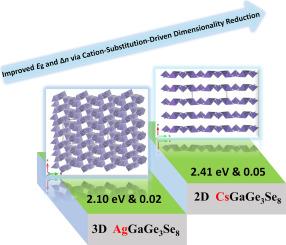CsGaGe₃Se₈:通过阳离子取代驱动的降维来增强光学各向异性和带隙
IF 5.4
3区 化学
Q1 CHEMISTRY, INORGANIC & NUCLEAR
引用次数: 0
摘要
通过控制Cs+掺入三维(3D) AgGaGe3Se8框架,展示了一种战略性降维方法,在保持化学计量的同时产生新的层状化合物CsGaGe3Se8。单晶x射线衍射显示其在P21/c空间群中结晶,呈现明显的二维层状结构,不同于母体的三维网状结构。综合表征表明,CsGaGe3Se8具有良好的热稳定性(高达600°C),直接带隙为2.41 eV,比母相(2.10 eV)提高了15%。该化合物具有广谱透明(0.43 ~ 25 μm)和中等双折射(Δncal = 0.05),比AgGaGe3Se8 (Δncal≈0.020)增强约2.5倍。这些发现表明受控的阳离子取代驱动的降维可以同时调制带隙扩展和光学各向异性。该研究不仅丰富了硒化物家族的高性能光学材料,而且为开发红外双折射光学晶体提供了一种可推广的结构设计范式。本文章由计算机程序翻译,如有差异,请以英文原文为准。

CsGaGe₃Se₈: Enhanced optical anisotropy and bandgap via cation-substitution-driven dimensionality reduction
A strategic dimensionality reduction approach is demonstrated through controlled Cs+ incorporation into the three-dimensional (3D) AgGaGe3Se8 framework, yielding the new layered compound CsGaGe3Se8 while preserving stoichiometry. Single-crystal X-ray diffraction reveals its crystallization in P21/c space group, exhibiting a pronounced 2D layered structure distinct from the parent 3D network. Comprehensive characterization shows that CsGaGe3Se8 possesses remarkable thermal stability (stable up to 600 °C) and a direct bandgap of 2.41 eV, a 15 % increase compared to the parent phase (2.10 eV). The compound exhibits broad-spectrum transparency (0.43–25 μm) and a moderate birefringence (Δncal = 0.05), representing an about 2.5-fold enhancement over AgGaGe3Se8 (Δncal ≈ 0.020). These findings establish that controlled cationic substitution-driven dimensionality reduction can concurrently modulate bandgap expansion and optical anisotropy. This study not only enriches the family of selenides with a high-performance optical material but also provides a generalizable structural-design paradigm for developing infrared birefringence optical crystals.
求助全文
通过发布文献求助,成功后即可免费获取论文全文。
去求助
来源期刊

Inorganic Chemistry Communications
化学-无机化学与核化学
CiteScore
5.50
自引率
7.90%
发文量
1013
审稿时长
53 days
期刊介绍:
Launched in January 1998, Inorganic Chemistry Communications is an international journal dedicated to the rapid publication of short communications in the major areas of inorganic, organometallic and supramolecular chemistry. Topics include synthetic and reaction chemistry, kinetics and mechanisms of reactions, bioinorganic chemistry, photochemistry and the use of metal and organometallic compounds in stoichiometric and catalytic synthesis or organic compounds.
 求助内容:
求助内容: 应助结果提醒方式:
应助结果提醒方式:


